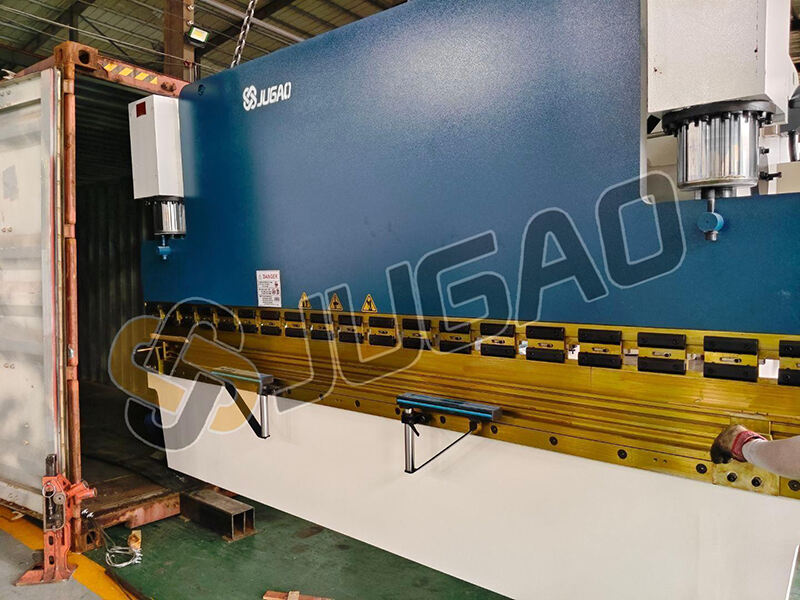Optimizing the Loading and Unloading of Machines in Containers: A Comprehensive Guide
Table of Contents
Step 1: Safe Lifting and Loading of the Press Brake
Step 2: Preparing the Container with Adequate Supports
Step 3: Positioning the Press Brake for Loading
Step 4: Safely Disengaging the Crane
Step 5: Loading the Machine with Forklifts
Step 6: Detaching Removable Components Before Loading
Step 7: Securing the Machine for Transportation
Step 8: Unloading the Press Brake from the Container
Step 9: Installing Removable Supports Under the Machine
Step 10: Extracting the Machine from the Container
Step 11: Final Removal of the Press Brake
Efficiently loading and unloading heavy machinery like press brakes into shipping containers is a critical task that demands precision and safety. Poor execution can lead to equipment damage, operational delays, and increased costs. This guide provides a detailed, step-by-step approach to ensure the process is both safe and efficient, minimizing risks and maximizing productivity.
Step 1: Safe Lifting and Loading of the Press Brake
To begin, use a crane with a capacity suitable for the press brake’s weight. Inspect the machine’s lifting points thoroughly and attach high-strength slings or chains securely. The crane operator should lift the machine slowly, maintaining balance to avoid sudden shifts. Once airborne, guide the press brake into the container, aligning it precisely with the designated placement area. Clear communication among team members is vital to prevent accidents and ensure a seamless operation.
Step 2: Preparing the Container with Adequate Supports
Before loading the machine, place removable supports or smooth iron plates inside the container. These supports stabilize the equipment during transit, preventing movement that could cause damage. The smooth surface of the iron plates facilitates easy sliding of heavy machinery into position. Proper preparation not only safeguards the machine but also streamlines the loading process, saving time and effort.
Step 3: Positioning the Press Brake for Loading
Using a forklift rated for the machine’s weight, lift the press brake to the container’s entrance. Align the machine carefully with the container’s opening and place it onto a removable unit or pallet designed for smooth movement. Adjust the position gradually to avoid imbalances. Once in place, secure the machine to prevent shifting during transport. This method ensures safe handling and simplifies unloading at the destination.
Step 4: Safely Disengaging the Crane
After the machine is securely positioned, disengage the crane cautiously. Ensure the press brake is stable and fully supported before releasing the lifting hooks. Lower the hooks slowly while monitoring the load’s balance. Once the weight is transferred to the supports, remove the slings or chains carefully. Clear the area of any obstructions before moving the crane away to avoid interference with further operations.
Step 5: Loading the Machine with Forklifts
Place removable supports or smooth iron plates under the machine’s legs to reduce friction. Use a forklift to push the machine smoothly into the container, maintaining alignment to prevent tilting. Operate the forklift at a controlled speed to ensure stability. Once inside, secure the machine with straps or wooden blocks to prevent movement during transportation.
Step 6: Detaching Removable Components Before Loading
Remove any detachable parts such as control panels, tool holders, or back gauges before loading. This reduces the machine’s dimensions, making it easier to fit inside the container and lowering the risk of damage. Label and store these components securely for easy reassembly upon arrival.
Step 7: Securing the Machine for Transportation
Use high-strength straps, chains, or slings to secure the machine inside the container. Ensure the fasteners are evenly tensioned and anchored to designated points. Regularly inspect the securing equipment for wear or damage to maintain safety throughout the journey.

Step 8: Unloading the Press Brake from the Container
Before unloading, remove all securing elements such as bolts and wooden braces. Use a forklift or crane to lift the machine, adhering to the manufacturer’s weight distribution guidelines. Ensure the unloading area is clear and the ground is stable. Lift the press brake slowly, maintaining balance, and place it on a secure surface for further setup.
Step 9: Installing Removable Supports Under the Machine
Position removable supports under the machine’s designated support points using a lifting device. This ensures even weight distribution and stability during handling. Verify that the supports are securely in place before proceeding.
Step 10: Extracting the Machine from the Container
Open the container doors fully and inspect for obstructions. Use a forklift or crane to pull the machine out slowly, keeping it balanced. Place it on a prepared surface and inspect for any shipping-related issues.
Step 11: Final Removal of the Press Brake
Using the same equipment employed for loading, carefully lift the press brake out of the container. Ensure even weight distribution to prevent tilting. Once removed, place it on a level surface and check for hazards before proceeding.

Thank you for choosing JUGAO. We are committed to innovation, collaboration, and delivering solutions that exceed your expectations.


















































